1. Formulation Guidelines
Calcium bromide (CaBr₂) is formulated as a high-density clear brine fluid for completion and workover operations, with concentration adjusted based on required density and well conditions:
A. Density-Based Formulations:
- Low-Medium Density (8.4-12.5 lb/gal):
- 30-45% CaBr₂ by weight
- Often blended with CaCl₂ (e.g., 70:30 CaBr₂:CaCl₂) for cost optimization
- High Density (12.5-14.2 lb/gal):
- 45-52% CaBr₂ by weight
- May require NaBr additions for density >14.2 lb/gal
B. Temperature-Adapted Blends:
- For cold environments (<10°C):
- CaBr₂/CaCl₂ blends (e.g., 50:50) to prevent crystallization
- Minimum 15% CaBr₂ to maintain inhibition properties
- For HPHT wells (>150°C):
- Pure CaBr₂ solutions preferred for thermal stability
- Typical concentration 38-45% for 11.5-13.5 lb/gal
C. Additive Packages:
- Corrosion inhibitors: 0.1-0.5% amine-based compounds
- Scale inhibitors: 0.05-0.2% phosphonate or polymer types
- Surfactants: 0.1-0.3% for water-wetting and debris removal
2. Mechanism of Action
A. Primary Functions:
- Hydrostatic Pressure Control:
- Provides precise density control (1.01-1.70 g/cm³)
- Maintains overbalance without solids content
- Equation: P (psi) = 0.052 × density (lb/gal) × TVD (ft)
- Formation Damage Prevention:
- Solids-free nature eliminates particle invasion
- Compatible with most reservoir minerals (except halite)
- Low fluid loss (<5 ml/30 min by API standard)
B. Chemical Mechanisms:
- Clay Stabilization:
- Ca²⁺ ions exchange with Na⁺ in smectite clays:
Clay-Na + Ca²⁺ → Clay-Ca + Na⁺ (reduces CEC by 30-50%) - Reduces clay swelling potential by 60-80% vs. freshwater
- Ca²⁺ ions exchange with Na⁺ in smectite clays:
- Shale Inhibition:
- Br⁻ ions penetrate shale micro-fractures
- Creates osmotic pressure to counter hydration forces
- Typical activity range: 0.6-0.8 aw
- Scale/Corrosion Control:
- Br⁻ reduces CaSO₄ precipitation by 70% vs. chloride systems
- Forms protective CaCO₃ film on steel at <0.1 mm/year corrosion rate
C. Thermal Behavior:
- Stable viscosity (<2 cP) up to 400°F (204°C)
- No thermal degradation below 500°F (260°C)
- Thermal expansion coefficient: 0.0004/°F (0.00072/°C)
3. Operational Advantages
A. vs. Conventional Systems:
| Parameter | CaBr₂ Brine | KCl Polymer | Oil-Based Mud |
|---|---|---|---|
| Formation Damage | Minimal | Moderate | Severe |
| Shale Inhibition | Excellent | Good | Fair |
| Temperature Range | -20°C to 260°C | 10°C to 150°C | -10°C to 200°C |
| Cleanup Required | None | Moderate | Extensive |
B. Economic Considerations:
- Typical cost: $1.50-3.00/lb dry product
- 30% cost savings vs. ZnBr₂ blends
- 15-20% higher cost than CaCl₂ but superior performance
4. Special Application Notes
A. Completion Fluids:
- Filter cake removal: 5-10% acetic acid spacers
- Perforating fluids: Blend with surfactants for debris control
- Gravel packing: Maintain density within ±0.2 lb/gal window
B. Workover Fluids:
- Kill fluid formulations: 7-10% density overbalance
- Well control: Rapid gas solubility (Henry’s constant 0.18 vs. 0.03 for CaCl₂)
- Suspension capability: 2-4 hours for 10 lb/1000gal fines
5. Quality Control Parameters
- Density tolerance: ±0.1 lb/gal
- Clarity: <50 NTU turbidity
- Iron content: <10 ppm
- pH range: 6.5-8.5 (adjusted with NaOH/HCl)
This optimized formulation approach ensures calcium bromide brines provide reliable performance while minimizing formation damage and operational risks in completion and workover operations.






